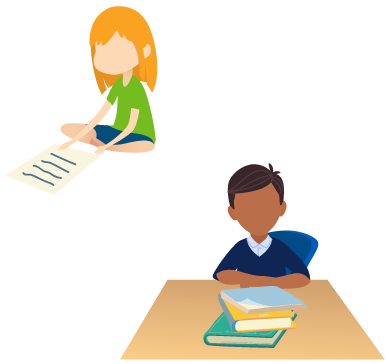Practical support for identifying and meeting need
Cognition and learning
Tips for developing literacy skills
Here are some ideas for supporting children and young people with key literacy skills:
Reading for meaning
- Start with audio-books or books that contain images.
- Demonstrate active reading skills and talk through your understanding of a text out loud.
- Select material on their favourite subject to start with.
- Activate prior-knowledge to relate the text to concepts they are already aware of.
- Make mind-maps or discuss the topic before the reading begins.
- Use contextual analysis to infer the meaning of a word by looking closely at surrounding text.
- Use semantic maps to help develop connections among words and increase the learning of vocabulary words.
- Explain the meaning behind abstract language.
- Play vocabulary games > (Vocabulary Ninja) and use synonyms, antonyms, roots as well as concepts to provide enrichment of new word meanings.
- Use Blooms Taxonomy > to develop knowledge, comprehension, application, analysis, synthesis, and evaluation.
- Further information on supporting reading and literacy in secondary schools >.
Developing a sight vocabulary
- Play with letter shapes and forms to help recognise visual word patterns.
- Introduce new sight words in isolation, but immediately follow this with repeated exposures to the same sight words in books and other text materials so that they are read in context.
- Use highlighters to find sight words within a photocopied story. Using audio books would enable them to do this independently.
- Do not introduce two sight words that are similar or easily confused at the same time.
- Make the learning goal manageable so that they do not feel overwhelmed.
- Create word searches > to practise finding the words but make sure the words only go from left to right.
- Use memory aides for words that they find difficult, e.g. mnemonics or create a rhyme that includes the word.
- Connect the word to an image by having the word on one side and a picture prompt on the other side, e.g. for ‘monarchy’ draw a crown above the word.
- Reinforce the words using multisensory activities, e.g. read the word and then write in the word to encourage the use of ‘muscle memory’.
- For older students teach spelling rules and the history of words, e.g. knife comes from the Old Norse word knifr and the k used to be pronounced.
- Play word games >.
NB: ‘Overlearning the Key to Success’ is available from your SI teacher
Phonic and decoding skills
- Develop phonemic awareness >.
- Ensure that everyone is using the pure phonemes. Exaggerate tongue and mouth movements if necessary. It can be helpful for children to feel their own throat while making the sounds and get the ‘feel’ of the sound. Mirrors are also a useful resource.
- Play games and read poetry to help recognise and generate rhymes. It is also important to be able to identify words that do not rhyme, e.g. sun, hot, run.
- Include activities to recognise onset and rime.
- Segment words into syllables by clapping, tapping, or counting.
- Sort words with similar sounds and identify the common phoneme.
- Delete phonemes from words, e.g. “Say dish. Now say it without the d.”
- Teach them to locate vowels (use the breve and macron symbols), then syllable divisions and then determine the syllable types, so that they can break a word into bite size pieces. They should be able to break a word into syllables orally and divide the printed word.
- Teach morphology by indicating prefixes, suffixes, and root words.
- Build words by adding prefixes and suffixes to root words to develop morphemic knowledge.
Spelling strategies
- The four key areas to focus on are accuracy (teach and practise), fluency (practise at speed), generalisation (practise in different contexts) and maintenance (retain accuracy over time).
- Make sure that they have a range of strategies and ask the key question, “What can I do to help spell this word?”
- Use phonological (understanding of phonemic awareness and alphabetic awareness), visual (the way words and letter combinations look), morphemic (the meaning of words and how they take different spellings when they change form) and etymological (word origins) knowledge to develop spelling.
- Follow a structured multi-sensory spelling programme and monitor their progress to ensure that they are applying the words in their independent writing.
- Focus on ‘little but often’ to promote success.
- Check that they know what the word means and learn it in context using simple dictation techniques.
- Analyse their writing to see if there are any patterns of error that need addressing explicitly. This will help to decide the most appropriate intervention or approach to use.
- Choose an intervention that works best for them, e.g. cued spelling >.
- Provide resources to support the spelling of words in class, e.g. word mats, ACE dictionary (or similar) and technology (e.g. Siri).
- Include dictionary training and explicit teaching about the use of other authoritative sources for identifying correct spellings and locating the correct definition of words when several are provided.
Help with handwriting
Children and young people need to be physically and developmentally ready before they begin to write. This includes both gross and fine motor areas:
- Gross motor factors: core strength, control and postural stability.
- Motor planning skills.
- Development of a consistent hand preference.
- Ability to coordinate both sides of the body together.
- The ability to reach across the midline of the body.
- Fine motor factors: Good wrist and hand function, finger dexterity.
- Development of a pincer grip.
- A functional grip > on the pencil.
From The component skills required (© National Handwriting Association):
Handwriting requires very fine perceptual judgements to be made and linked together. Visual perception and visual memory are two key areas which impact on handwriting.
Visual motor integration is necessary, which consists of coordinating visual perceptual skills together with gross and fine motor movement. This enables a child or young person to visually observe a letter or shape and then make the required movements to reproduce that letter or shape with a pencil on paper. Before children are developmentally ready to learn letter formation, they need to be able to copy and draw simple geometric shapes including the oblique cross X.
Unlike other movement skills, handwriting is language based and involves learning the conventions of a written script. Other important cognitive components include:
- An interest in talk and communication through mark making.
- Sufficient cognitive ability to pay attention, follow instructions and remember letters and shape formations.
- An understanding of prepositional language such as up, down, in front, behind, top, bottom so that they can follow verbal handwriting instructions.
Handwriting can be a difficult skill for some children to master. Motivation and engagement are essential to maintain self-esteem for all, but especially for those who struggle. The way handwriting is introduced at the very beginning will have a lasting effect on their confidence. This awareness should permeate all aspects of the curriculum and be shared with the whole school community.
Left handers can experience particular challenges. Here are some tips for left handed writing > (PDF).
Specialist – additional support for children and young people with an ongoing and significant identified need
Learning environment
- There is regular access to highly skilled/trained staff that are familiar with those who have severe and persistent literacy difficulties (including dyslexia) or those with other learning difficulties.
- Specialist interventions are bought in from outside school, e.g. Rotherham Enhanced Action for Dyslexia (READ) > – for children and young people with severe and persistent literacy difficulties who are in Year 4 to Year 9.
- Attention is given to celebrating strengths in other areas.
- There are opportunities to access learning across the curriculum which are not literacy based.
Access to the curriculum
- Evidenced based highly structured 1:1 intervention is in place (e.g. Reading Rescue and Fischer Family Trust) with frequent opportunities for overlearning.
- Specific difficulties around phonics > are addressed.
- Timetabled sessions to revise and consolidate what has been learned using multi-sensory activities are offered.
- There is use of Precision Teaching >.
- Targets are set by a Specialist teacher.
- A monitoring system is in place to assess needs, plan and identify outcomes, implement support and monitor and evaluate progress, e.g. SEN support plan.
- Robust review > takes place with pupil, family >, specialists, class teacher, Teaching Assistant and SENDCo. Link to Partnership section re working with parents
- Regular review meetings > and consider an Individual Education Plan/One Page Profile >.
- See also the person centred reviews section >


